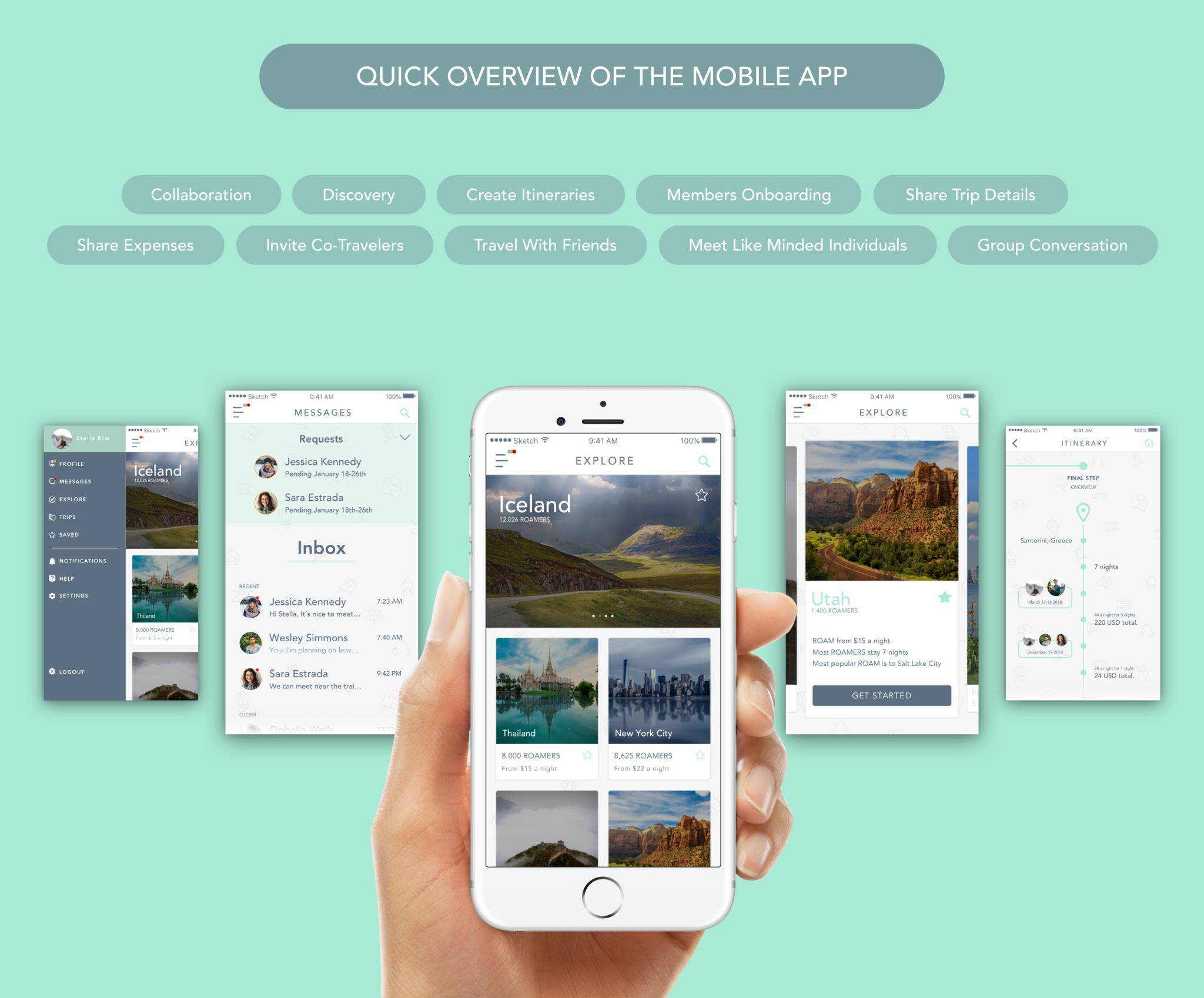
01
INTRODUCTION
Project Overview
Meet Roam, a mobile room-sharing service for connecting like-minded travelers with lodging accommodations.
Roam connects its users to lodging accommodations based on travel dates and likelihood of compatibility through mutual interests, mutual dislikes, and points of interest. Whether you are traveling alone or with company, use Roam to coordinate travel itineraries, find lodging accommodations and split travel expenses.
Roam stimulates economic growth within the travel industry while shaping the future of travel expectations. It’s my vision to provide opportunities that encourage unique social opportunities and exploration for all travelers.
Roam is more than a place to sleep it’s a gathering place for life-enriching experiences.
Share your world. Cheaper. Smarter. Together.
Project Logistics
MY RESPONSIBILITIES & ACTIVITIES
My role was to research, design and test the entire experience and all design artifacts related to the project. The goal was to develop an experience and supporting UI that would showcase a minimum viable product to be demoed to potential investors.
ROAM was designed with a focus on monetary and social value. This is the driving focus that I kept in mind as the value proposition to refine and build around while I engaged in each step of the Design Thinking process.
Currently, I am working to refine the matching system logic associated with connecting travelers in the best way possible. Enhancing traveler preferences that I call “Essentials” and “Nice to Haves” will be the next step in increasing user satisfaction, allowing users to be even more selective of who they travel with and in what context.
MY INVOLVEMENT
From conception to birth, Roam has been a project I envisioned and turned into a reality. The core idea that I came up with is something I refined and expanded upon through iterative feedback sessions that captured the voice of actual users.
DESIGN TOOLS & UX METHODS
Sketch, Invision, UserTesting, discovery research, interviews, direct observations, competitive design analysis, 10x brainstorming, affinity diagram, How Might We questions, personas, journey mapping, sketching, mockups, clickable prototypes.

PROCESS
I engaged in empathy methods including observations, interviews, and surveys to better define and understand the problem at hand as well as to continually test and measure the iterative changes that were made based on new findings.
I broke the challenge into four tasks:
- Understand the problem
- Understand the users
- Ideation and user journey
- Interaction design and prototype
PROBLEM DEFINITION
Engaging in unique social opportunities is a challenge for strangers because they are meeting for the first time.

The Design Sprint
WEEKS 1 – 3
Problem Definition
- Simplify the problem into something addressable
Research
- Discovery research
- Direct observations
- Interview users who:
- Have experiences with planning group trips
- Travel frequently
- Have never traveled or done so infrequently
Competitive design analysis
WEEKS 7 – 9
Testing
- Direct observation
- Iterate design based on user feedback
Visual Design
- Create high-fidelity UI and a clickable working prototype
WEEKS 4 – 6
Ideation
- Ideate solutions that address users pain points and the hypotheses
- Evaluate the ideations and create the information hierarchy
10xing brainstorm phase
Synthesize interview notes into insights
Affinity diagramming
Develop How Might We questions
Create Personas
Journey Map
Prototyping
- Design low-mid fidelity wireframes
WEEKS 10 – 12
Testing
- Direct observation
- Iterate design based on user feedback
Deliver
Finalize high fidelity visual design
Package up all developer ready design assets
02
DISCOVERY & ANALYSIS
Direct Observations & Interviews
Direct observations allowed me to view what users actually do in context. I focused my attention on how users engaged in the booking and checkout process’. I was able to capture activities that would have otherwise gone unnoticed.
Direct observations helped me to understand what users struggle with and why they struggle. However, because they can be intrusive and subjects may alter their behavior due to the presence of an observer, I conducted interviews as well. I used the insights gained from my direct observation to help me generate information for new interview questions.
I wanted a more superficial look at what users were doing, what they want, and what they think (the more interviews I completed, the greater my confidence was in their perspective). These interviews gave me a better understanding of the varying types of personalities that may interact with my product, their opinion of my product, and the issues they encountered.
These methods require little to no cost, other than minor incentives for participants (Amazon gift cards). The correct and most efficient methods start with the question – what do you want to learn?

03
DESIGN
Visual Design
The visual design, content strategy, information architecture, and feature sets were all driven by user empathy methods within a Design Thinking framework. It was this Design Thinking framework that allowed ROAM to realize failed interactions early, often, and in a safe prototypal environment before development dollars were to be spent and vital visceral reactions were formed by the public.
Increasing Fidelity as Ideas Solidify
I prefer to start my design process during the ideation phase with very low-fidelity methods, like sketching or paper prototyping.
With ROAM, I sketched out many initial ideas based on the many thoughts I had while analyzing competitors. As I started showing my sketches to potential users and gathering feedback, I refined my ideas repeatedly until I felt like I had a fairly solid base of app features.
With this initial confidence, I moved into medium-fidelity wireframes and gathered additional feedback through a few more rounds of prototype-based show-and-discuss style interviews with users.
The more feedback I received, the more refined ROAM became – eventually I felt confident enough to spend the time implementing the most updated set of requirements in hi-fidelity mockups and a clickable prototype.
The feedback process never ends, it only moves from validating major ideas to fine-tuning over time. I believe that the world is constantly changing and the cycle of gathering feedback and making refinements will always be necessary.
Prototypes
My medium-fidelity prototypes were used in UserTesting with 5 additional users to gauge between two of the major design options. Many ideas were validated and invalidated. One instance was the decision to use “explore” as the homepage, another was to launch the app with a detailed on-boarding process. Users found the “explore” homepage option far more engaging and 4 out of 5 mentioned that it helped immediately demonstrate ROAM’s purpose and gave them a good mental image of what the app was for and why to use it. The option using “explore” as a homepage won by a landslide.
Font & Color
Avenir Roman, Avenir Medium, Avenir Heavy, #A9EAD6, #5B6F81

04
REFLECTION
From Knowledge to Design
In 12 weeks ROAM became the newest concept in travel innovation. Through cycles of inspiration to ideation and implementation, my iterative design process fueled ROAM’s inviting and trustworthy content strategy and helped create an overall design that allows for harmony between user desires and business goals.